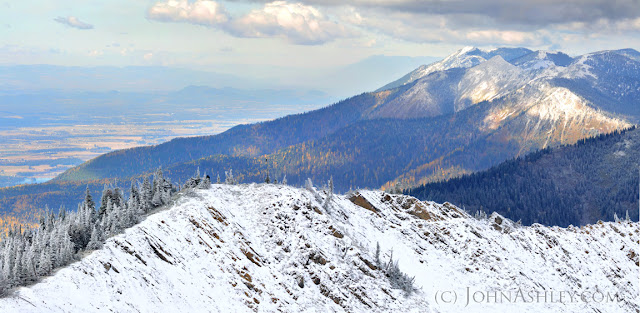 |
| Jewel Basin Hawk Watch site in northwestern Montana |
Look closely at this photo (click to enlarge). See that dark spot at the peak of the snowy ridge in the foreground? See that person behind the tree, the one standing for hours on end in 26 degrees, constantly scanning the sky through frozen binoculars, hoping for more wind?
That's a birder.
Make that, a volunteer birder - and a darned good one at that. They (there's actually two birders present) are at the observation site for the Jewel Basin Hawk Watch project, which just finished its fourth year.
The fall raptor migration is pretty much over for the year, up here in northwestern Montana. The river of birds flowing southward has slowed to a trickle here, but what an amazing spectacle.
 |
| Soaring Red-tailed Hawk |
Over the last four years, our local Hawk Watch project has averaged 259 hours of observation over 42 days (late August through early November). And virtually all of this effort has come from 50+ volunteers under the guidance of Dan Casey. If you're tied into the birding world, then you already know Dan. I consider him to be the most knowledgeable, amiable and humble bird biologist in the greater northwest.
Dan found this local bottleneck in the raptor migration corridor, and he manages this massive project with a minimal amount of occasional funding from Flathead Audubon, Plum Creek Foundation, US Forest Service, and the American Birding Conservancy.
Some bird numbers. Over 46 fall days, this year's volunteers observed 17 different raptor species, including 12 Peregrine Falcons, 160 Red-tailed Hawks, 327 Cooper's Hawks, 393 Golden Eagles, and 1088 Sharp-shinned Hawks! This year's grand total of 2468 raptors was slightly higher than the four-year average, but a bit below last year's total of 2741 raptors.
An additional benefit from our local Hawk Watch is that many of the birds fly close enough that observers can age (immature vs. adult) more than 70% of the raptors. This can give the biologists a rough idea of production, or how many young each species was able to raise, that can be compared year-to-year.
There are several similar sites across Montana. Eventually, you will be able to read the results of our local site on the nonprofit Hawk Migration Association of North America's website. On that site, you can also learn more about the Bridger Mountains Raptor Migration Project, located in south-central Montana, near Bozeman.
Comparing just these two sites, you can begin to see how this "river" of feathers flows through Montana. For example, Golden Eagle numbers peek in mid-September up here, but not until mid-October down there.
So much valuable information, gained from such breath-taking sites. Maybe now it's easier to see why so many top birders are happy to volunteer for a project like Hawk Watch.
"Eventually, all things merge into one, and a river runs through it." (Norman Mclean)

